CHEAT SHEET
- The business case. When considering intensity of innovation, female presence equates to US$44 million in firm value.
- Outside responsibilities. One in four women has taken a leave of absence from work to provide dependent care, compared to one in 20 men.
- Looking elsewhere . The percentage of women who say it was difficult to find a new position after an absence from the work force doubles from three in 10 to six in 10 if the leave extends beyond one year.
- Return to force. The OnRamp Fellowship, in partnership with the ACC Foundation, provides women with a path back into the workforce after taking a leave of absence.
There has never been a better time to capitalize on the talents of female in-house counsel, yet women continue to face real barriers to advancement. High-performing female lawyers exiting the legal profession leave a “leaky pipeline” to senior legal positions. It is in these senior positions that women have the greatest effect on the bottom line; hence, efforts to repair this pipeline may be necessary sooner rather than later.
Research demonstrates a positive relationship between women in leadership positions and favorable business outcomes. According to research published in the American Sociological Review, “gender diversity is associated with increased sales revenue, more customers, and greater relative profits.”1 However, challenges still exist in the pursuit to advance diversity and inclusion, despite women being just as ambitious and pursuing leadership positions at the same rate as men. Bain & Co. found that only 15 percent of women believe they are competing on a level playing field and are seen as having high potential.
1 Herring, Cedric. (2009). “Does Diversity Pay? Race, Gender, and the Business Case for Diversity,’’ American Sociological Review, 74(2): 209-224.
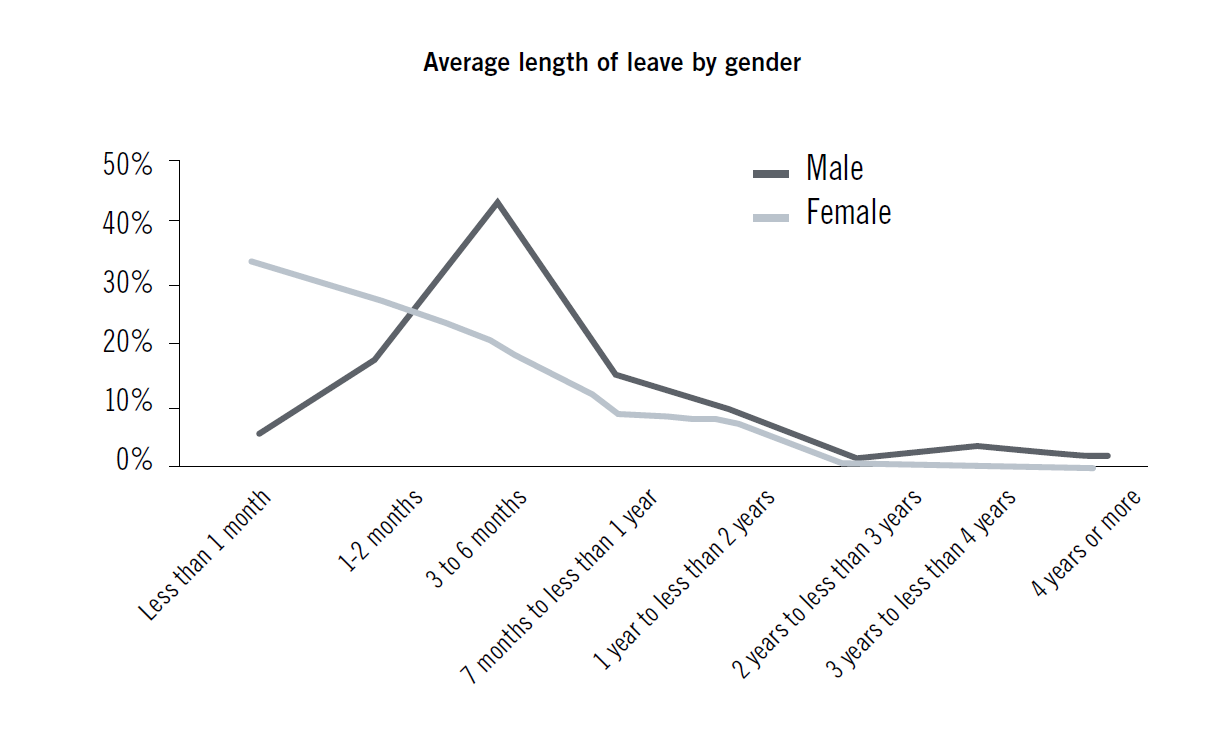
In an effort to examine the cause and effect of women leaving the legal profession, as well as potential disruptors, ACC studied more than 2,000 in-house counsel this year and combined these findings with data from previous research and outside sources. The findings spotlight the business case for women in senior leadership roles and explain why women enter, stay, and leave their in-house counsel positions. Returnship programs and shifts toward insourcing among legal departments also play an increasingly significant role in opportunities for female lawyers today.
“Even though I am essentially on call 24 hours a day, I still feel pressure if I have to leave early or come in late (or not at all) due to a childcare issue.”
— General counsel, finance and banking industry
The business case for attracting, hiring, and retaining female in-house lawyers
Female leaders are good for business. The presence of women in leadership roles has a positive effect on both innovation and revenue. When considering intensity of innovation, female presence equates to US$44 million in firm value.2 Fortune Magazine and The Wall Street Journal reported that women do indeed contribute to positive business outcomes, offering a wider variety of critical skills to their company boards in important areas, such as governance and risk management.
2 Dezso C.L. and Ross D.G. (2012). “Does Female Representation in Top Management Improve Firm Performance? A Panel Data Investigation in Strategic Management,” Journal of Strategic Management, 33 (9): 1072-1089.
In addition to understanding the business impact, it is important to recognize that work-life balance drives talented lawyers to in-house positions. Published in 2014, the ACC Global Work-life Balance Report found that work-life balance was a large factor for 55 percent of in-house lawyers, and at least somewhat of a factor for an additional 27 percent. This means that eight in 10 in-house counsel seriously considered work-life balance when they chose an in-house position. Expect these numbers to grow. A 2015 Bain & Co. study found that more than half of women and 44 percent of men say they imagine a career path that enables them to take career breaks without jeopardizing their opportunity for promotion.
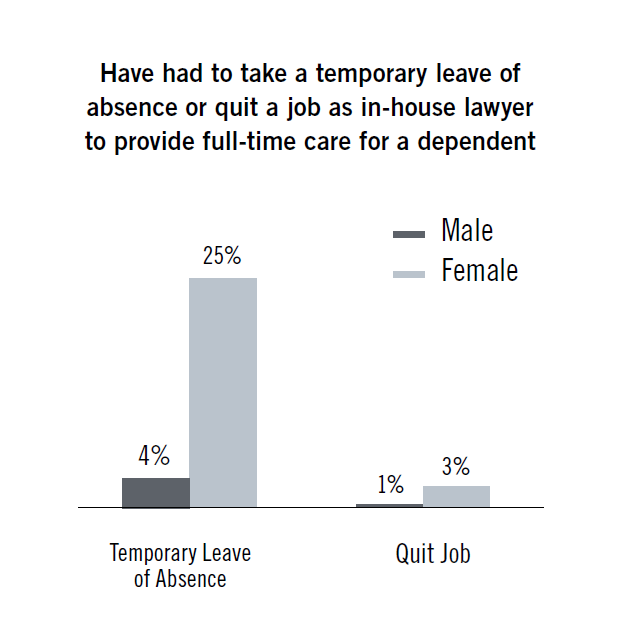
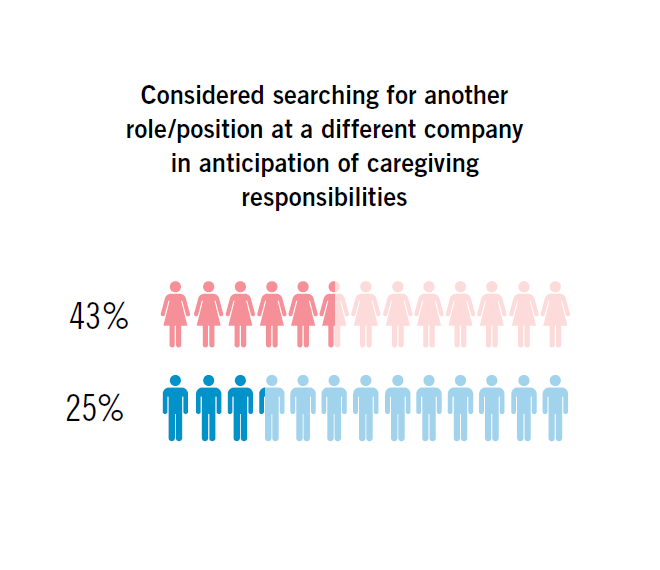
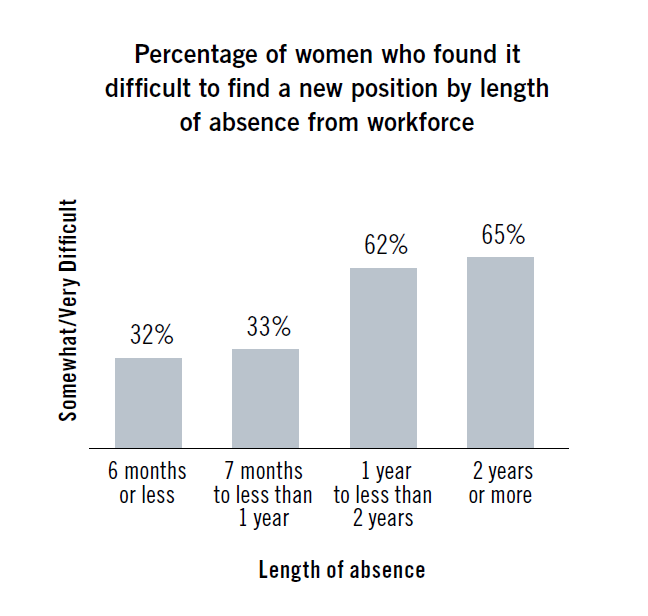
A highly mobile workforce
It is well known that turnover and the subsequent loss of corporate knowledge is expensive, costing organizations between one-half to five times the salary in replacement costs. Recent findings from a soon to be released ACC study indicate that in a highly mobile workforce, these costs can be excessive, and it appears lawyers are on the move. Eighteen percent of female in-house counsel and 15 percent of male in-house counsel switched companies in the past year, and one in three say they are likely to leave the in-house profession for a different position or career opportunity. Six in 10 in-house counsel would leave their job for a career advancement opportunity, 16 percent would make a lateral move today, and one in five has taken a leave of absence for caregiving or other personal reasons.
“On return, I learned the company was going to promote my maternity leave replacement to general counsel, above me. They had assumed, without asking, that I was not on career track because I took maternity leave and came back four days/week. I straightened them out.”
— Corporate counsel, information technology industry
Though male and female in-house counsel have similar patterns of mobility in many ways, women are disproportionately affected by caregiving responsibilities. Women were significantly more likely than men to have taken temporary leave of three to six months — in line with maternity figures in the United States. One in four women has taken leave to provide dependent care, compared with one in 20 men. Four percent of female in-house counsel say they have had to quit a job to provide full-time care to a dependent, compared with about one percent of male in-house counsel. These findings align with a recently published Gallup study, which found that having children has the largest influence on employment decisions of US women.
These numbers are important because they help to explain why some women leave in-house positions and provide a window of opportunity for companies to implement policies and programs to retain them. A compounding factor is that women do not have a positive view of how caregiving affects their advancement opportunities. A staggering seven in 10 women who participated in The ACC Global Work-life Balance Survey said that caregiving had a negative impact on their opportunities for advancement. There is a perceived expectation that career success can be attained only at the expense of caregiving; however, a large proportion of in-house counsel are caregivers who also want to advance their careers. Sixty-two percent of women are parents to a child under 18 years old, while one in three is a parent to a child under three years of age. Over half of Generation X in-house counsel with fewer than five years of experience have a child under two years old.
The impact of work-life balance and caregiving goes beyond the current caregiving population. Forty-three percent of female in-house counsel have considered searching for another role or position at a different company in anticipation of caregiving, compared with 25 percent of men, according to the The ACC Global Work-Life Balance Report. For this group, the attraction to an in-house position based on perceptions of work-life balance dissipates when considering the reality of corporate practice and the demands of caregiving.
Paying attention to perceptions and expectations of work-life balance will aid legal departments and corporate leadership with attracting, retaining, and advancing female in-house counsel who have the power to influence business metrics. Women are just as likely as men to work outside of regular business hours, as noted in the The ACC Global Census. Additionally, female in-house counsel who are caregivers spend 41 hours per week caregiving, compared with 30 hours for male caregivers. Though women work fewer hours per week than men, the average week for women totals 88 hours of caregiving and work compared with 80 hours for men (ACC, 2014). Thus, flexibility and a unique approach to individual situations may indeed support the retention of talented women lawyers.
“Taking reduced work hours/part time/flex time, while sometimes available, drastically reduces (or even eliminates) professional advancement opportunities. This also reduces professional credibility.”
— Corporate counsel, information technology industry
Returning to work
One of the challenges associated with returning to work after an absence is making the transition back to the workplace — and for those who leave, it is explaining the gap in employment. Forty-two percent of in-house counsel said it was difficult to find a position after taking a leave of absence. For women returning to work, six in 10 characterized their new job as desirable — a position that matches one’s career goals, professional experience, skills, and compensation requirements. The length of absence may play a role in the level of difficulty women have finding work after taking time off.
The percentage of women who say it was difficult to find a new position after an absence from the workforce doubles from three in 10 to six in 10 if the leave extends beyond one year. The percentage of women who report taking a desirable job also shrinks considerably for those out of the workforce for a year or more. Recruiters and hiring managers often overlook candidates with significant gaps in their job history, and lawyers are no exception.
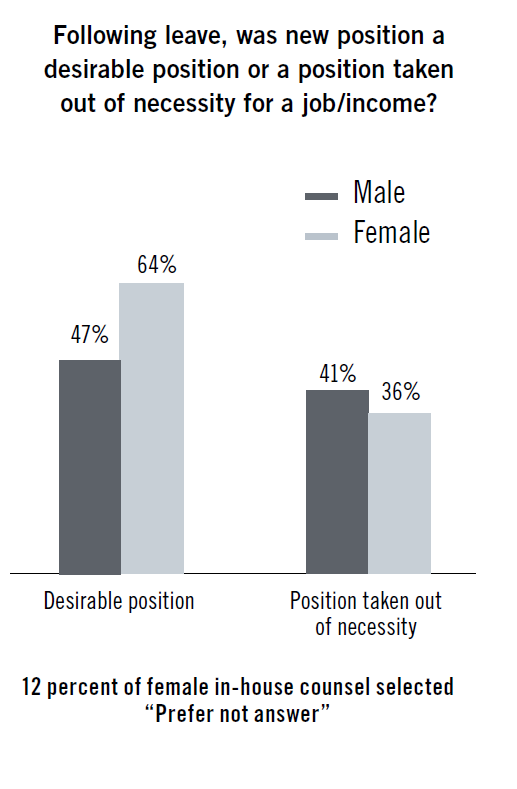

Competing with new graduates and other experienced lawyers, women seeking to return to an in-house position may find getting to the screening phase to be one of their greatest challenges. In fact, according to a recent interview with Caren Ulrich Stacy, founder and CEO of Diversity Lab and OnRamp Fellowship, talented lawyers who temporarily exit the workforce have traditionally lost out to lateral candidates who did not take time off. Highly specialized programs may play a vital role in making the connections between law departments and women returning to the job market. Stacy notes that since organizations usually hire and advance lawyers based on seniority and tenure, it is difficult for a woman and her potential employer to know where she fits into the traditional structure upon re-entry.
The OnRamp Fellowship was specifically developed to support this talented applicant pool in finding suitable law firm and in-house positions as well as to assist employers with tapping into this previously inaccessible group of experienced lawyers. The partnership between OnRamp Fellowship and the ACC Foundation, called OnRamp In-house, provides women with a much-needed inroad back to the workforce and positions that harness their talent.
“There is a perception that as a soon-to-be working mom, I want to ‘mommy-track.’ I don’t. I want to ‘lean in,’ but not at the expense of personal and family relationships, health, etc. I’m an advocate of reclaiming the 40-hour work week and working smarter, not ‘harder’ (i.e., longer).”
— Senior counsel, energy industry
A world of opportunity for corporations
Some companies may be unaware of the success of returnship programs, which are designed to make it significantly easier for companies to experience the benefits of diversity. Through OnRamp In-house, ACC members, including 3M, Microsoft, Amazon, Bank of Montreal, and Barclays are now making strides on gender diversity in an entirely new way. OnRamp In-house has opened a new point of entry on the diversity pathway by increasing the number of experienced female lawyers in the United States, Canada, and the United Kingdom. Participating legal departments have already tangibly gained highly motivated, experienced female lawyers.
These leading companies recognize the value of investing in talented women because they drive positive business outcomes, bring broad and needed skills to the legal department, and have the wisdom to be high performers. And there is room for expansion.
Corporate law departments and law firms have an opportunity to realize the benefits associated with gender parity by adopting talent acquisition programs that provide pathways for re-entry platforms and consciously remove barriers for female in-house counsel on the road to senior leadership.
“There are too few women in management so the pervasive belief in face time and policies that allow part time work or job sharing are not enacted.”
— Managing counsel, telecommunications industry




